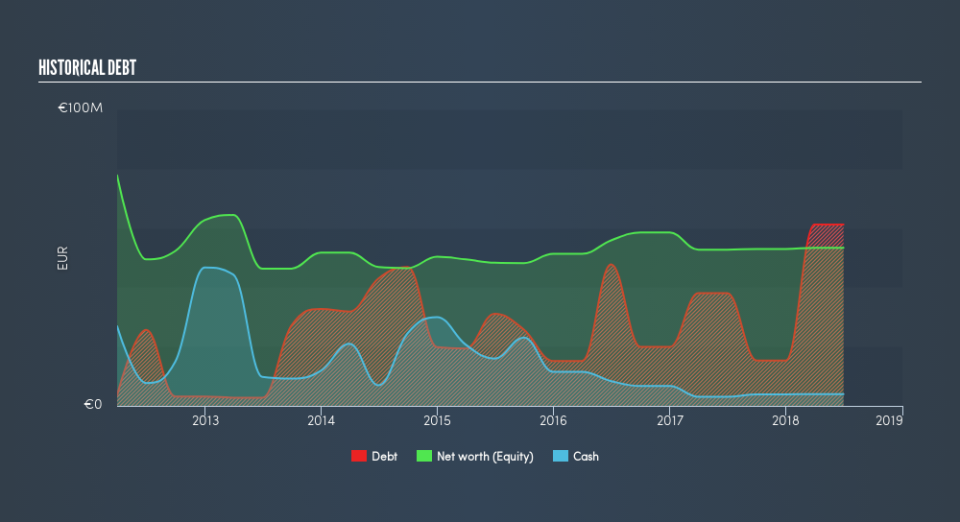What Investors Should Know About Delticom AG’s (ETR:DEX) Financial Strength

While small-cap stocks, such as Delticom AG (ETR:DEX) with its market cap of €87m, are popular for their explosive growth, investors should also be aware of their balance sheet to judge whether the company can survive a downturn. Understanding the company’s financial health becomes crucial, since poor capital management may bring about bankruptcies, which occur at a higher rate for small-caps. The following basic checks can help you get a picture of the company’s balance sheet strength. However, these checks don’t give you a full picture, so I suggest you dig deeper yourself into DEX here.
Does DEX Produce Much Cash Relative To Its Debt?
DEX’s debt levels surged from €38m to €61m over the last 12 months , which accounts for long term debt. With this increase in debt, the current cash and short-term investment levels stands at €4.0m , ready to be used for running the business. Moving on, operating cash flow was negative over the last twelve months. As the purpose of this article is a high-level overview, I won’t be looking at this today, but you can take a look at some of DEX’s operating efficiency ratios such as ROA here.
Does DEX’s liquid assets cover its short-term commitments?
At the current liabilities level of €159m, it seems that the business may not be able to easily meet these obligations given the level of current assets of €141m, with a current ratio of 0.88x. The current ratio is the number you get when you divide current assets by current liabilities.
Does DEX face the risk of succumbing to its debt-load?
Since total debt levels exceed equity, DEX is a highly leveraged company. This is a bit unusual for a small-cap stock, since they generally have a harder time borrowing than large more established companies. We can test if DEX’s debt levels are sustainable by measuring interest payments against earnings of a company. Ideally, earnings before interest and tax (EBIT) should cover net interest by at least three times. For DEX, the ratio of 4.58x suggests that interest is appropriately covered, which means that lenders may be inclined to lend more money to the company, as it is seen as safe in terms of payback.
Next Steps:
Although DEX’s debt level is towards the higher end of the spectrum, its cash flow coverage seems adequate to meet debt obligations which means its debt is being efficiently utilised. Though its lack of liquidity raises questions over current asset management practices for the small-cap. This is only a rough assessment of financial health, and I’m sure DEX has company-specific issues impacting its capital structure decisions. I recommend you continue to research Delticom to get a better picture of the stock by looking at:
Future Outlook: What are well-informed industry analysts predicting for DEX’s future growth? Take a look at our free research report of analyst consensus for DEX’s outlook.
Valuation: What is DEX worth today? Is the stock undervalued, even when its growth outlook is factored into its intrinsic value? The intrinsic value infographic in our free research report helps visualize whether DEX is currently mispriced by the market.
Other High-Performing Stocks: Are there other stocks that provide better prospects with proven track records? Explore our free list of these great stocks here.
We aim to bring you long-term focused research analysis driven by fundamental data. Note that our analysis may not factor in the latest price-sensitive company announcements or qualitative material.
If you spot an error that warrants correction, please contact the editor at editorial-team@simplywallst.com. This article by Simply Wall St is general in nature. It does not constitute a recommendation to buy or sell any stock, and does not take account of your objectives, or your financial situation. Simply Wall St has no position in the stocks mentioned. Thank you for reading.


